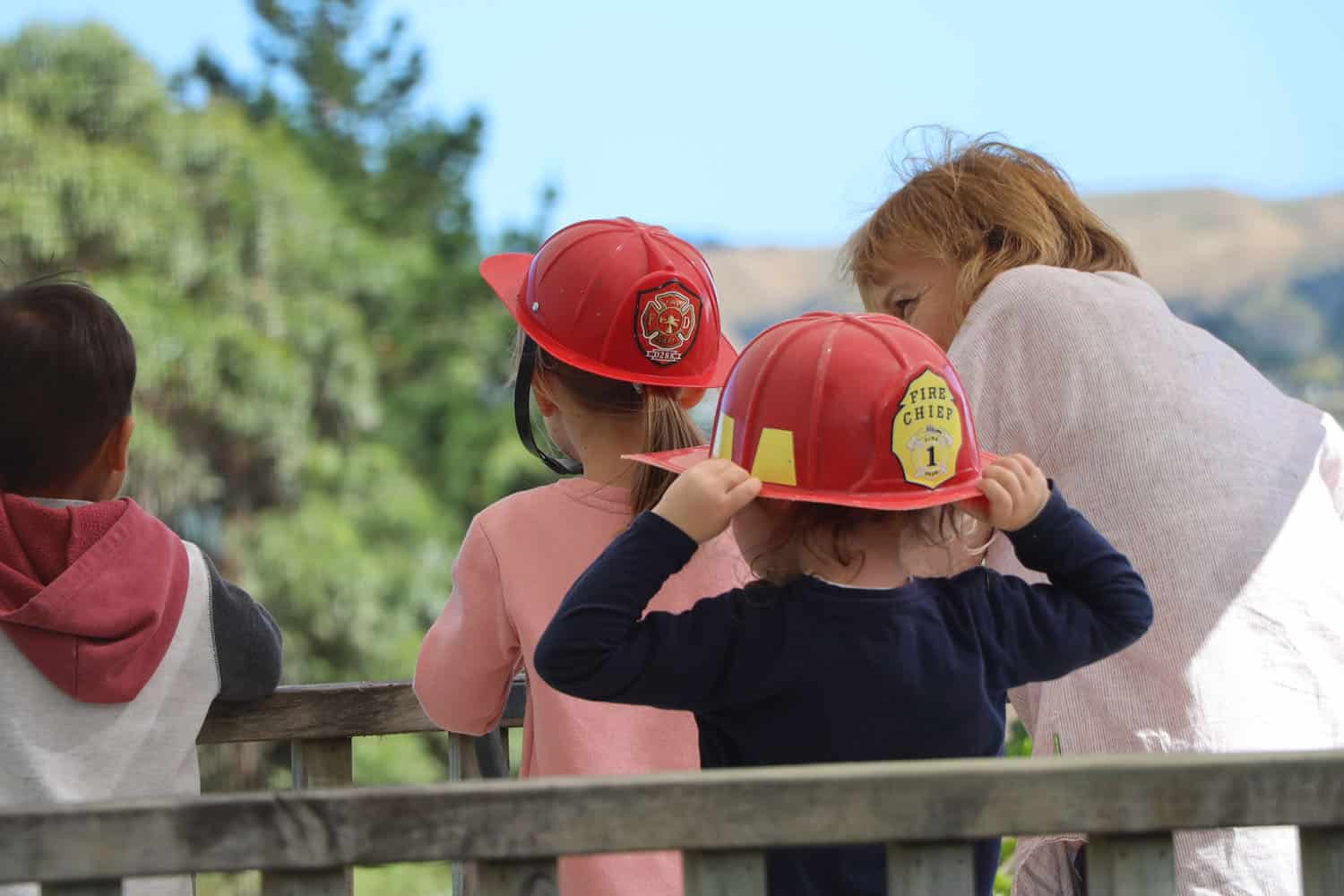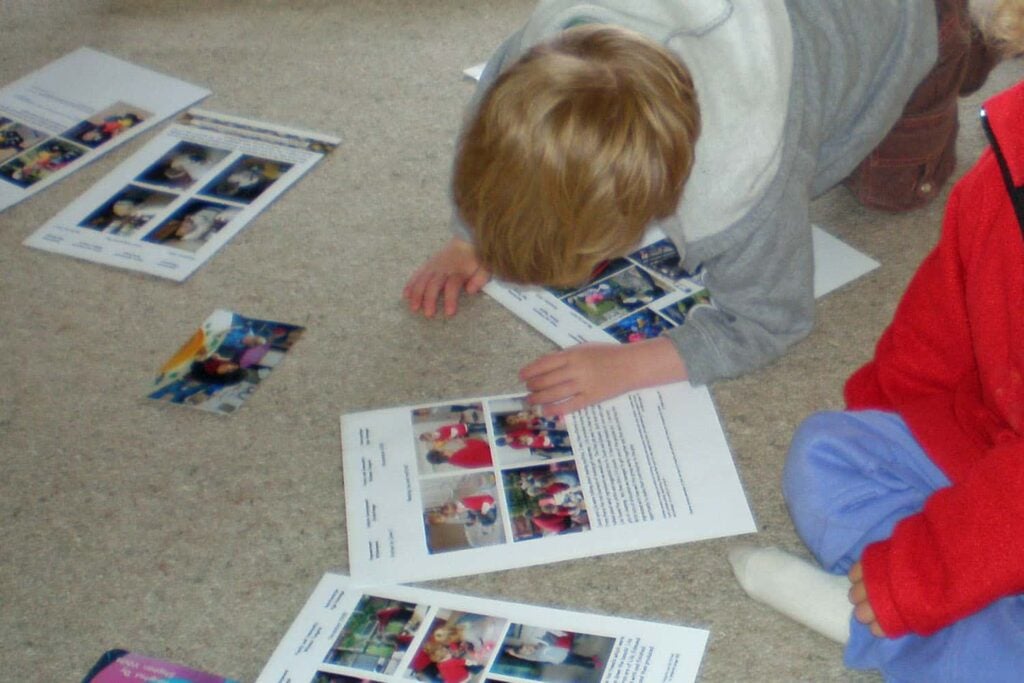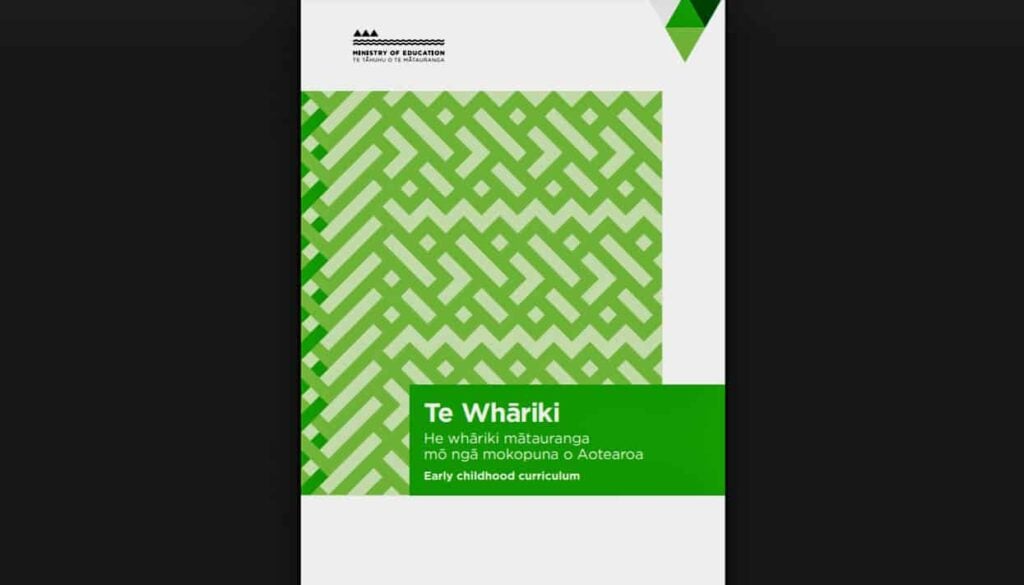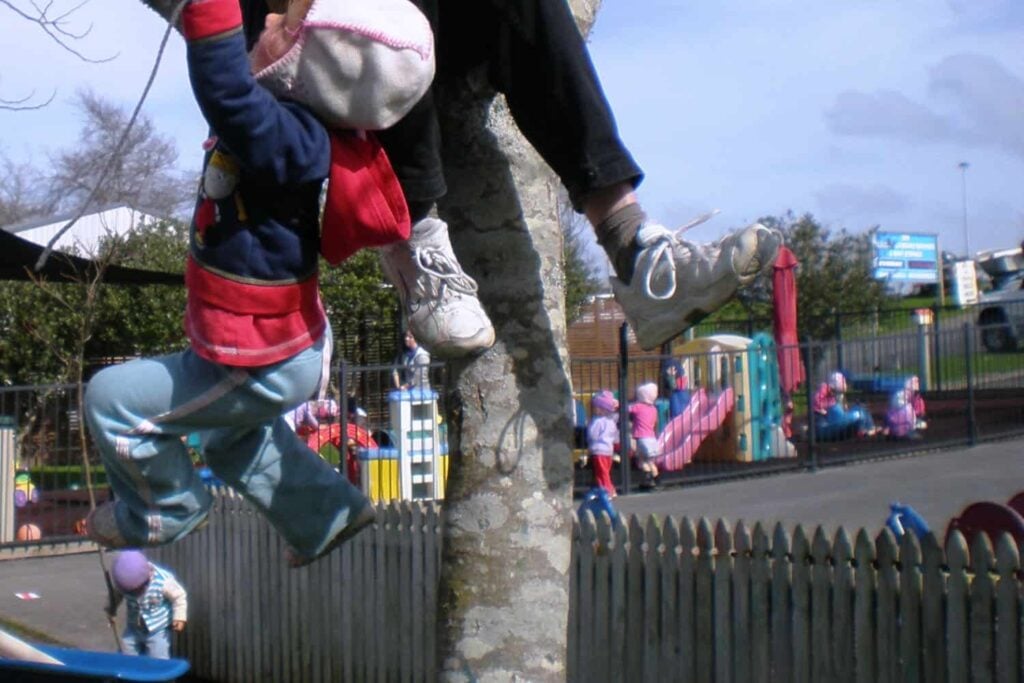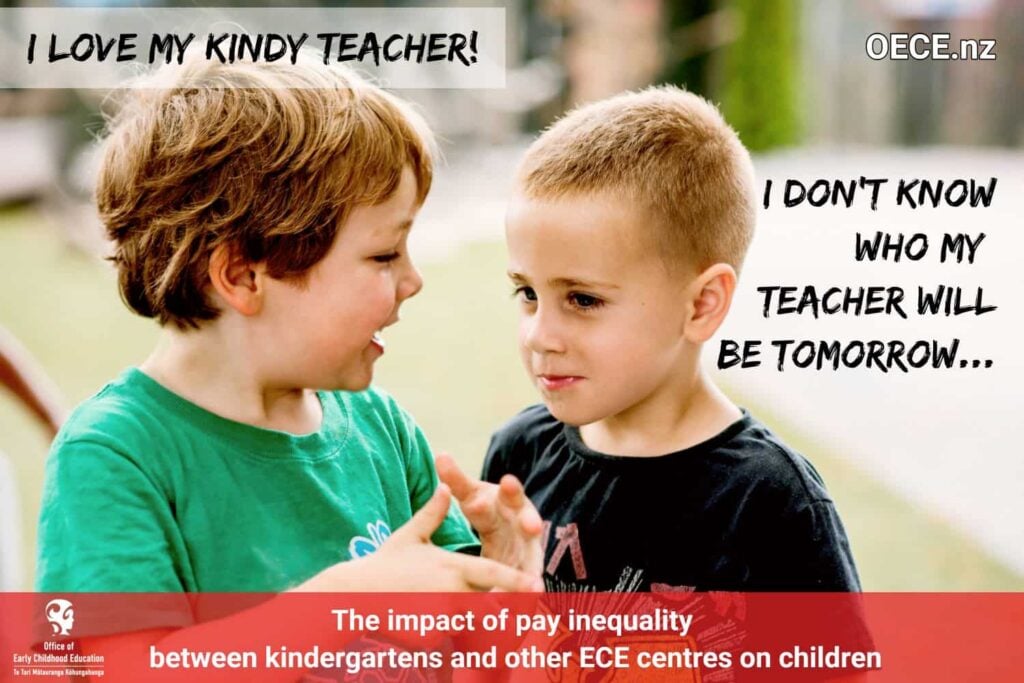Timeline of Early Childhood Education Events.
1982 –The first Kohanga Reo opened and Kohanga Reo were funded via local Maori management groups and Vote: Maori Affairs.
Pre-1986 –Childcare services were within the social welfare sector. Playcentres and Kindergartens as part-day services that involved parents either as teachers (Playcentres) or in parent-helping and home-visits (Kindergartens) were within the education sector. Getting childcare recognised as education became a focus of feminist and trade-union lobbying as a way that would lead to a socially acceptable expansion of childcare services to allow more women to engage in paid work and not be tied to domesticity.
1986 – Government transferred administrative responsibility for childcare centres and family daycare services from the Dept of Social Welfare to the Dept of Education.
1987 – The Early Childhood Workers Union (for childcare workers) amalgamated with the Kindergarten Teachers Union and later formed a combined union. It was hoped that this would raise the status and benefits of childcare work whilst giving a larger political voice for kindergarten and childcare employees alike.
1988 – Education to Be More, report of the Government’s Early Childhood Care and Education report was released. It advocated for bulk funding of services and closing the gap in funding differences between childcare and kindergarten. Also recommended the introduction of national standards for government to set a baseline of quality across ECE services. Eight working groups were formed to provide advice on implementation.
1988 – Three year early childhood training for a diploma introduced for working in both childcare and kindergarten services.
1989 – Government budget provided for a staged plan for higher funding per child, per hour subsidy up to 30 hours a week to childcare centres and kindergartens, with a higher amount for under-2s
1989 (Aug) – Early childhood services received the Early Childhood Management Handbook details minimum standards to work towards complying with and how to prepare a charter. Services were asked to develop and negotiate a charter with the Ministry of Education before 1 July 1990. Funding was linked to being chartered.
1990 (Sept) – Legislation for new minimum standards finally passed. Charters not able to be approved until minimum standards met, so deadline moved forward to June 1991.
1990 (Dec) – Early Childhood Management Handbook was replaced by the Statement for Desirable Objectives and Practices (DOPs). Widespread sector disillusionment with the process of implementation as many of the Handbook requirements were subsequently watered down in the DOPs. The DOPs removed the necessity for quality to be higher than the minimum standards for chartering.
1990 –Kohanga Reo transferred from the Dept of Maori Affairs to the Dept of Education which meant having to come to terms with the regulatory environment and expectations of a mainstream government department and the ECE sector.
1991 – Government stopped the Before Five, bulk funding staged plan to make funding equitable across the ECE sector. Funding rate for children under-2 years was lowered. Regulation preventing kindergartens from charging fees was removed. Three new reviews carried out on staffing, funding, and property.
1992 – Education (Home-based) Order regulations promulgated.
1994 – The combined childcare/kindergarten teachers union joined with primary teachers in the NZEI. It was hoped that this would increase wage and status benefits e.g. wage parity for all early childhood employees with primary school teachers.
1996 – The Diploma of Teaching become a benchmark for quality in the introduction of a new funding package for centres that employed one staff member with a Diploma of Teaching.
1996 – The final version of Te Whariki– a curriculum for all types of early childhood services was launched by the Prime Minister and incorporated into revised compulsory standards (DOPs).
1996 – Statement of Desirable Objectives and Practices revised.
1997 – Kindergarten teachers removed from the State Sector Act – principally to enable childcare to have equity with kindergarten and reduce kindergarten industrial negotiating power.
1997/98 – NZ’s first academic peer review journal for early childhood research was founded by Dr Sarah Alexander
1998 – The Education (Early Childhood Centres) Regulations promulgated.
1999 – Change of government and kindergarten teachers brought back under the State Sector Act.
2001 – NZ Teachers Council formed and given jurisdiction by government over professional standards in the teacher-led ECE sector.
2002 – Pay parity: Kindergarten teachers’ pay was linked to primary school teachers’ pay.
2002 – ECE Ten Year Strategic Plan Pathways to the Future: Ngâ Huarahi Arataki.– resulted in government: (a) funding thousands more places in teacher-led ECE services, (b) taking on a new role of ECE network management and planning to get more children into ECE services in communities where participation was lowest, (c) introducing equity funding for community-based ECE services, (d) providing funds for significant teacher supply initiatives including incentive grants to ECE services to support staff to become qualified, (e) ECE scholarships for Maori and Pasifika trainee teachers, and (f) setting targets for percentages of ECE qualified teachers in centres – 50% by 2007; 80% by 2010; 100% by 2012.
2003 – Ministry of Education begins a review of regulations for ECE.
2004 – The Government decides on a three-tied regulatory framework – The Education Act, A new set of early childhood regulations (2008) and criteria which are regulations that can be prescribed and changed by Minister of Education at will. Between 2004 and 2008 the Ministry carried out three phases of consultation. Implementation of the regulatory framework was delayed in 2008 by a change of government.
2005 – The flat-rate funding system changed to a cost driver system based on the cost structure of running an ECE service including outcomes of kindergarten wage rounds. Funding bands introduced to incentivise teacher-led services to meet registered teacher targets set in the ECE Strategic Plan.
2007 – 20 Hours Free ECE funding introduced. A significant policy shift from government providing a subsidy – to government covering the fee charges. The policy created two groups of services: teacher-led and parent-led. Initially when the 20 Hours Free was announced in the 2004 Budget: “From the middle of 2007, three and four-year old children will be entitled to 20 hours free attendance per week at a community-based early childhood education service. This is a significant step, extending the tradition of free early childhood education from kindergartens to other community-based centres.” (2004 Landmark Budget). But lobbying leading up to the 2005 general election saw the Labour-led government agree to extend the 20 Hours ECE funding scheme to include private ECE providers and allow services to levy parents with optional charges. Kindergarten associations attracted to the 20 Hour Funding scheme sought to maximise their income by applying to the Ministry of Education to re-licence kindergartens as full-day education and care centre operations. By 2011 there were few sessional kindergartens and by 2018 there were none (see open letter – Save our public free kindergartens)
2008 (Nov) – Education Minister announces a review of the regulations that came into effect on 1 December 2008 and appointed a working group to prepare a report, which the Ministry consulted on and provided feedback to the Minister.
2009 – 20-Hours ECE funding extended to playcentres and kōhanga reo.
2009 (July) – Changes to Government decisions on licensing and criteria are announced. All ECE services to go through process of being re-licensed under the 2008 revised regulations including criteria.
2010 – Removal of the funding band for more than 80% qualified and registered staff. Kindergartens return to being funded at a different rate to childcare services, with kindergartens providing sessional ECE funded for 100% qualified/registered staff.
2010 (Oct) – ECE Taskforce established by Education Minister to review ECE funding and set priorities for the next 3 – 5 years. No voice on the ECE Taskforce for parent-led services and home-based services; and NZEI Teachers’ Union and NZ Childcare Assn excluded also. Only 439 submissions received with 314 said to be on a standard form issued by NZEI.
2010 (Nov) – Centre funding for ECE qualified teachers opened to also include employing registered primary school trained teachers to care for under-sixes.
2011 (July) – Government increases the maximum allowable number of children from 50 to 150 in a licensed early childhood centre premises and from 25 to 75 children under two-years to 75. The rationale being that an increase in licence size (a de-facto regulation for group size) will save money in duplicate paperwork and help centres save on registered teacher staffing costs by spreading registered teachers across their previously separate centre licences.
2011 (July) – Support grant for provisionally registered teacher limited to those working in services with below 80% qualified/registered teachers
2011 (June – Aug) – Close on 4,000 responses received to the Ministry of Education online survey seeking feedback on the recommendations of the ECE Taskforce report, with a disproportionately high response/reaction rate from playcentre and home-based services compared with kindergarten and childcare.
2011 (Oct) – The Education Minister makes the first of a possible series of announcements following Ministry of Education consultation on the ECE Taskforce report. The funding system for ECE is to be changed, the ECE curriculum is to be reviewed, government is to get involved in directing parents to choose the ‘right’ ECE through web-based interactive tools, and a number of sector advisory groups are to be established.
… this Timeline of Early Childhood Education Events is to be updated soon. Please check back
2016 – The Parents as First Teachers Programme (PAFT) which had been running successfully for 25 years was scrapped by the Government
2017 (April) – A revised ‘Te Whāriki’ published by the Ministry of Education, following its hasty release by the Minister of Education.
2019 (Dec) – A ‘10-Year Early Learning Action Plan‘ released by the Minister of Education Chris Hipkins, emulating a previous Labour Party Education Minister (Trevor Mallard’s) Government’s 10-Year ECE Strategic Plan.


